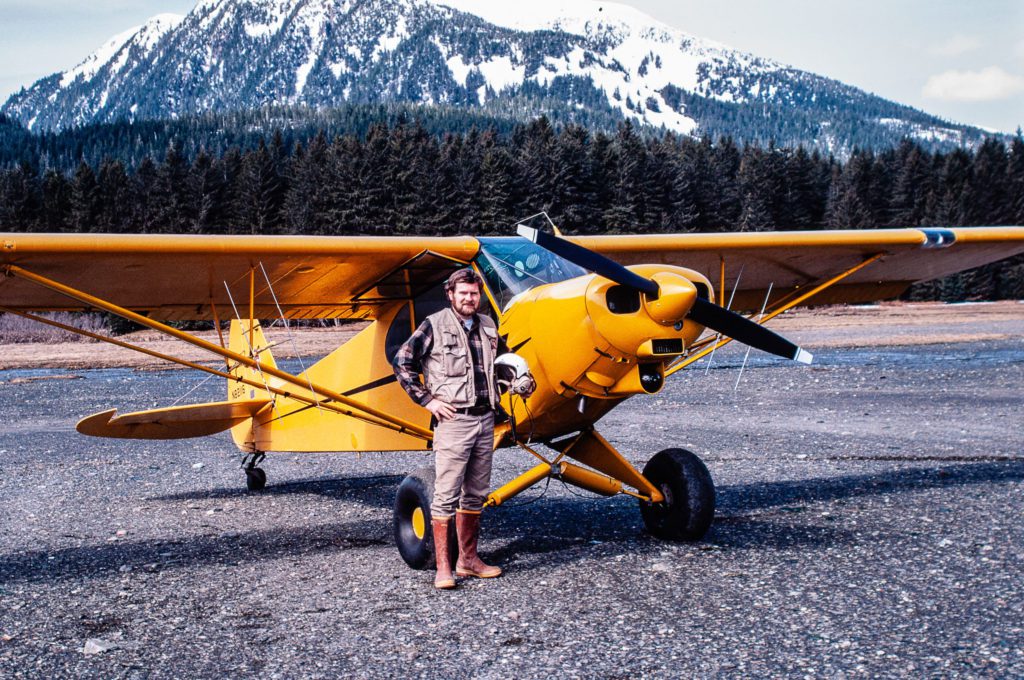
By Mary Catharine Martin
For The Cordova Times
In 1977, John Schoen flew to Hood Bay on Admiralty Island. He’d been hired by the Alaska Department of Fish and Game as the first Southeast Alaska research biologist to study deer, and this was his first trip into the field.
“Flying into the bay, looking at humpback whales and all the bald eagles in the trees… we got out of the Beaver, stepped on the beach and saw these huge, enormous brown bear tracks,” he recalled. “And listening to the blue grouse, and the geese on the beach, I just thought, ‘Man, I’m getting paid to do this? Unbelievable!’”
Forty-four years later, he’s made a career studying and working to conserve deer, mountain goats, brown bears and Alaska’s ecosystems, and he’s written a book about the journey: “Tongass Odyssey: Seeing the Forest Ecosystem through the Politics of Trees; A Biologist’s Memoir.”
“What we learned is that old-growth forest is very important,” he said of research he did with U.S. Forest Service research biologist Charlie Wallmo and fellow ADF&G research biologist Matt Kirchhoff. “Clear cuts were used by deer in the summertime, when there was an abundance of food, but in the wintertime, when the snows came, the deer couldn’t use them. In the second growth, the deer would have to pack a lunch to make it through. There’s just nothing on the forest floor.
“One thing led to another. We published our results, and then we took tremendous flak from the Forest Service and the timber industry. I quickly realized that the science was hard to do without bumping into the politics.”
At times, that politics seemed to threaten his job. Twice in the 1980s, he was invited to testify before Congress about his research. Though his immediate supervisors and the then ADF&G deputy commissioner were supportive of his work, higher-ups in state government were not. The state of Alaska first told Congress he was unavailable — then that there was no money to send him. That wasn’t true. He felt strongly enough about his duty to share what he had learned with the American public that he took annual leave to go testify each time, even taking out a loan to be able to afford the plane ticket.
“I just said, you know, if they don’t want me to go back that much and I have done this work on behalf of the public — it’s a public resource — I have to go back [to D.C.],” he said. “It’s my responsibility.”
As he branched out into researching brown bears and mountain goats and as his knowledge deepened, he began thinking about old-growth forest a different way.
“The value of old growth isn’t [just] deer habitat,” he said. “The value of old growth is as an ecosystem. A very unique ecosystem. The old-growth forest is a patchwork quilt of all these different kinds of stands, from shore pine to mountain hemlock that may be six inches in diameter and two or three hundred years old.
“Old-growth forests are not renewable. You cannot clear cut a forest that has 800-year-old trees in it and expect it to come back in a hundred years to have the same structure and function of an old-growth ecosystem.”
Later in his career, he was the lead scientist for Audubon Alaska. He organized a letter from seven professional societies representing more than 30,000 scientists to then Secretary of Agriculture Tom Vilsack — whom President Joe Biden has reappointed in the position — about the importance of transitioning out of old growth clearcutting on the Tongass. They never got a response. But he’s hopeful that the Forest Service policy of allowing clear cut old growth logging on the Tongass will change, especially since even more research is coming out, with a recent study estimating the Tongass stores 44% of the carbon in all U.S. national forests.
Schoen published “Tongass Odyssey” in September of 2020. He’s inspired by people’s shifting idea of what was “normal,” the too-slow pace of change he had seen in 40 years of U.S. Forest Service management of the Tongass, and the endangered status of the Tongass’s remaining large-tree old growth, which represents just 3% of the forest.
“We still have an opportunity to keep the diversity of forest habitats on the Tongass National Forest,” Schoen said. “There’s no other national forest in the nation where we have this opportunity.”
“Tongass Odyssey” was published by University of Alaska Press and is available at cdv.tiny.us/odyssey.
Mary Catharine Martin writes for SalmonState, an Alaska-based initiative which works to ensure Alaska remains a place wild salmon and the people who depend on them thrive.





